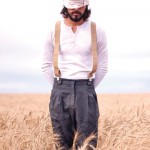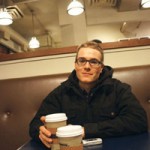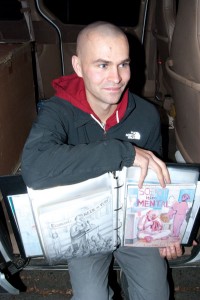Market Collective – A Series of Artists
by Claire Miglionico
Market Collective did not sprout out of the earth magically. It took the creative and bedazzled minds of creators Angel Guerra and Angela Dione, both 29, and a group of art lovers who fell hard for the concept. “I think we both meshed our ideas (well) together,” said Guerra at a meet-up at Vendome Cafe in Sunnyside. “We’re both fairly social and before you knew it, we both started getting more into it. And then all of a sudden people started getting on board with it. It was almost at the point where we just had to do it because we were so far in and we did it and loved it and kept going with it”.
Although Guerra and Dione act like life-long buddies, their friendship only blossomed with the Market.
“Yeah, it’s pretty crazy. We never knew each other a long time before the Market. It was the Market that really got us to know each other,” said Dione.
“It’s almost (been) three years. It’s kind of a long time now,” added Guerra. Both Dione and Guerra never thought Market Collective was going to evolve into the success it has become today. “We had no concept. We just wanted to do a market and have a bunch of people have fun in the city,” said Dione. “I don’t think we thought too much about the future. We thought we’ll do this one and if it goes good, maybe we’ll do another one. Probably after the second one we were sold and started doing it a lot and decided we’d just keep going until there’s a reason why it couldn’t,” said Guerra with a laugh.
Market Collective now opens its doors every two months. Anyone can check it out for a toonie. Artisans of all kinds display diverse artwork for sale ranging from jewellers, to graphic designers, to paint- ers while musicians perform original sets to the crowd. The next Market is opening its doors Oct. 30-31 and will be Halloween/fall-themed. It will be the fourteenth market run by Dione and Guerra.
As a little sneek-peak into next Market Collective, Guerra revealed the presence of a hunted stairwell, a pumpkin- carving room, and “a fairly mystical photo booth” that looks like a life-size chess board in a field. Dressing-up is certainly welcomed, she said.
Apart from the market, Guerra works at a homeless shelter part-time and is taking on an education degree at the University of Calgary to be- come an English teacher. As for Dione, she has recently made the decision to take on Market Collective full-time starting February although she said it was a hard decision to make.
“I think that in terms of the success that the market collec- tive has had, it’s been a little bit magical in a sense that, the city needed it at the time that we were able to provide it and we both work so hard at making it what it is today,” said Dione.
Reuben Bullock
by Bianca Dayrit

Reuben Bullock is a solo artist in Calgary’s folk music scene. He has always been involved in music locally, planning shows, getting people together and renting venues out.
“I’ve always been doing that kind of stuff and that’s where it kind of all started,” he said. Bullock has been on board with Market Collective from day one. As the Market’s official music co-ordinator, he handles the music artists’ bookings and scheduling, and generally helps out for every Market Collective.
Lately, he has decided to pull himself back from the live scene and is keeping it low-key for the time being. “I want to make sure there is a lot more effort that goes into each show that I perform. I want to keep it sacred, so when I do a show, it has been built up to that point,” he said. One of Bullock’s current projects includes the music video for the song “The Devils Time” from his album Pulling up Arrows, which he recently finished filming and is now anticipating the final product.www.myspace.com/reuben-bullock
Tyler Los-Jones
by Bianca Dayrit

Tyler Los-Jones is a Calgary-based artist engaged in several projects in Calgary’s art and music scenes. He once had a block printing demonstration at Market Collective, co-founded “809” – a residential garage art space, and is currently involved in the all- ages music venue “Local Library.” Los-Jones graduated as a painter from ACAD in 2007. He realized the technicalities of painting, like colour, were taking away from what he wanted to express in his pieces. Now, he keeps his work very simple using minimal to no colour. He says it helps him think more about the content behind the piece, as opposed to just the outward appearance.
Los-Jones is currently working on a project called “In Passing.” It emerged as a result of his curiosity of the ecosystem and as a non-logical answer to the “logi- cal conclusion” he was taught. He pondered black holes – a symbol for “the end” and he began looking into the way we perceive extinction by researching species that have become extinct in Canada since 1985, the year he was born.
“It’s a play between when a species becomes extinct in reality, and when the species becomes extinct in our self-conscious,” he said. Using black washes on white paper, he uses the high-contrast drawings to camouflage the common English names of the extinct species. “I think the magic of art is that multiple associations can be pulled out of this one object. That’s the one really special thing that art can do really well.”
Ryan Jason Allen Willert
by Sheena Manabat
Ryan Jason Allen Willert’s art is undeniably and authentically native. Willert, 26, is a Calgary- based artist who hails from the Siksika Nation. Common motifs in his drawings and paintings include animals and spiritual images. Now working full-time as an artist, Willert was invited to join Market Collective by his friends Angel Guerra and Angela Dione, founders of the Market. He has displayed and sold his artwork in two Market Collectives so far. Willert has found many outlets for his art locally. His artwork has been published many times in New Tribe Magazine and he is presently a board member for the Urban Society for Aboriginal Youth.
Willert has also made a few films: a documentary and anima- tions with Calgary’s Quickdraw Animation Society when he joined their program Aboriginal Youth Animation Project. His films and art have been featured at the Glenbow Museum as well. Additionally, Willert has had a stand at the Calgary Stampede for years, has taught workshops and has spoken at high schools about his art. Though currently finding success as an artist, Willert overcame adversity to get to where he is today.
At 18, Willert met his family here in Calgary and for almost a year, lived on the streets where he panhandled, skateboarded, and got drunk. It was from his family that he first learned about native artwork and how to sell it. However, his life on the streets was shortlived as he eventu- ally joined a life skills program for Aboriginals with Personal Support and Development Network. Here, he honed his skills and cleaned himself up and since then, has been sober and selling his art on the street. Willert attributes his sobriety to his love of art. “Ever since I started doing native artwork I’ve been off the streets. I’ve pretty much quit drinking,” he said. “Native artwork has really helped me a lot, it’s changed my life.”
Andrew Gable
by Zoey Duncan

Photo by Zoey Duncan Andrew Gable's art is a reflection of his mindset, which is focused on equality worldwide.
Andrew Gable’s life is work in progress. Since returning to Calgary from South Africa three months ago, he’s been deep in thought about what it means to be an artist in a world where
famine, poverty and death are significant problems. “What I believed about art before is not what I believe now,” he says, choosing his words carefully. Art used to be intrinsic to Gable’s life; it was a need that he likens to an addiction that he was dependant on. “I convinced myself I needed it,” says the ACAD alumnus, who graduated from the drawing program in 2004. Gable’s art became, at times, something to hide behind. He says that when times got tough, he would go paint a picture instead of facing an issue.
“For a long time I perceived art as having some kind of value and almost in a way enslaved myself to it,” he says. “You can’t eat art and you can’t feed it to people who need (to eat).”
Gable recently spent some time in South Africa with a group that is sharply focused on worldwide equality, including an equitable money system for all.
So, while Gable is questioning the role of art in his life, (“How could an art school exist when there’s millions of people dying?” he asks.) the art he makes has adopted the ideals of equality and questioning the status quo. His series “Comical Sense,” which he created while in Africa, features mixed media pieces using acrylic paint, watercolour and pencil crayon. Each canvas features a play on words, such as “Bible” being transliterated as “Buy-Bull,” alongside an image of a white-haired man, holding a book with a hole punched through it, seated next to a bull and manure.
Gable will be selling originals of these and other work at Market Collective.






